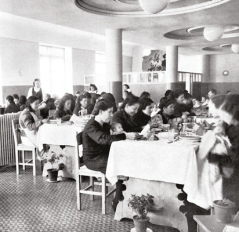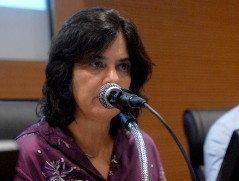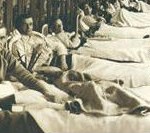March 2020

Leprosy Prophylaxis Institute c.1924. Source: FIOCRUZ – Fundo Souza-Araújo.
In studies of philanthropy and welfare concerning leprosy in Brazil, historians have noted the role played by certain women from the ruling classes, as of the mid-1920s, in supporting the patients through societies for the care of people with leprosy. These studies often note that these philanthropy and welfare activities were imbibed with an authoritarian nature and geared towards segregating the bodies of the poor, seen as potential foci of contamination of a “healthy society”. However, the historiography has not investigated the socioeconomic status of the women involved in the leprosy cause. More often than not, they are clumped together as “ladies from the elite,” but little is known of their biographical trajectories.
In the essay “Women from the Federation of Societies for the Care of Lepers and Defense Against Leprosy, 1926-1947”, Francieli Lunelli Santos and José Augusto Leandro, professors from the Universidade Estadual de Ponta Grossa (Paraná, Brazil), take a look at the family profiles of women holding key decision-making positions in the Federation of Societies for the Care of Lepers and Defense Against Leprosy (Federação das Sociedades de Assistência aos Lázaros e Defesa Contra a Lepra, FSALDCL) in different parts of Brazil.
Using prosopography as a research method and technique, the researchers collated information on women who were closely involved in Brazil’s health policy concerning leprosy from the mid-1920s to the late 1940s. The research confirms the involvement of the women in the control and management of the country’s preventoria and suggests that the social and professional standing of the fathers and/or husbands of the women who ran the federation was an element that influenced their actions towards the disease.
“Alongside the religious values based on compassion for those afflicted with leprosy commonly held by the elite at the time, it is likely that other factors also played a part in the engagement of the women with FSALDCL. One of these must have been their family environment, where the menfolk overwhelmingly had careers in the military, in medicine, and in politics, often holding public office. This may have inclined the women to take charitable action towards the children of people with leprosy”, notes the article.

Asylum Cocais. Treatment installations. Source: FIOCRUZ, Fundo Souza-Araújo.
The research confirms that many of the fathers and/or husbands of the women involved in leprosy care in Brazil were rich and endowed with considerable political capital, holding high public office. This fact should be seen in conjunction with the political strength of the preventorium project embraced by the women, which, the article points out, that it survived intact for decades, well into the civil-military dictatorship, which began in 1964.
Today, the legal provision of financial compensation is being discussed in the National Congress with the purpose of mitigating, to some extent, the traumatic experience of the great many people forced to spend their childhood and adolescence in preventoria across Brazil.
Read the full article:
Antos, Francieli Lunelli and Leandro, José Augusto. Women from the Federation of Societies for the Care of Lepers and Defense Against Leprosy, 1926-1947. Hist. cienc. saude-Manguinhos 2019, vol.26, suppl.1, pp.57-78
Read in HCS-Manguinhos blog:
Leprosy and segregation in colonial Mozambique
The paper indicates the different views on leprosy between locals, doctors and missionaries.
The anti-leprosy campaign in Colombia, 1920-1940
The article discusses the replacement of the segregation approach by a more general public health strategy.
Leprosy: a short history
The Centre for Global Health Histories publication examines leprosy’s impact on society from the medieval period up to the present day.
V. 10 • supplement 1 • 2003 – Leprosy: a Long History of Stigma
ANALYSIS Leprosy and the elusive M. leprae: colonial and imperial medical exchanges in the nineteenth century. JO ROBERTSON abstract Social representation of Hansen’s disease thirty years after the term ‘leprosy’ was replaced in Brazil.
Read in HCS-Manguinhos:
BOTERO-JARAMILLO, Natalia; MORA-BLANCO, Jessica and QUESADA-JIMENEZ, Nelson Daniel. Historial oral y memoria de los enfermos de Hansen en dos lazaretos de Colombia: trayectorias de vida, conflictos y resistencias. Hist. cienc. saude-Manguinhos 2017, vol.24, n.4
LEVISON, Julie H.. Beyond quarantine: a history of leprosy in Puerto Rico, 1898-1930s. Hist. cienc. saude-Manguinhos. 2003, vol.10, suppl.1
MONTEIRO, Yara Nogueira. Prophylaxis and exclusion: compulsory isolation of Hansen’s disease patients in São Paulo. Hist. cienc. saude-Manguinhos. 2003, vol.10, suppl.1
PANDYA, Shubhada S.. The First International Leprosy Conference, Berlin, 1897: the politics of segregation. Hist. cienc. saude-Manguinhos. 2003, vol.10, suppl.1








